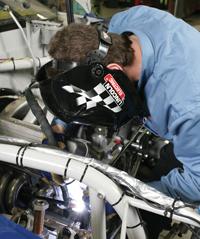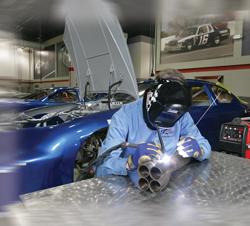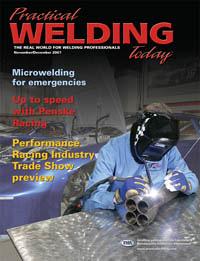- FMA
- The Fabricator
- FABTECH
- Canadian Metalworking
Categories
- Additive Manufacturing
- Aluminum Welding
- Arc Welding
- Assembly and Joining
- Automation and Robotics
- Bending and Forming
- Consumables
- Cutting and Weld Prep
- Electric Vehicles
- En Español
- Finishing
- Hydroforming
- Laser Cutting
- Laser Welding
- Machining
- Manufacturing Software
- Materials Handling
- Metals/Materials
- Oxyfuel Cutting
- Plasma Cutting
- Power Tools
- Punching and Other Holemaking
- Roll Forming
- Safety
- Sawing
- Shearing
- Shop Management
- Testing and Measuring
- Tube and Pipe Fabrication
- Tube and Pipe Production
- Waterjet Cutting
Industry Directory
Webcasts
Podcasts
FAB 40
Advertise
Subscribe
Account Login
Search
Up to speed
Welders at Penske Racing strive for strength and safety
- November 6, 2007
- Article
- Arc Welding
NASCAR® roots run deep in the American Southeast. More than 50 years ago, atop sandlot racetracks with haystack walls, local thrill-seekers sought mere bragging rights behind the wheels of their modified family sedans.
Today's racecars cost upward of $200,000, and the stakes are among racing's highest. The cars scarcely resemble any street-legal machine, incorporating technology that has more in common with jet aircraft than anything driven to a peewee soccer game.
The bodies alone are products of highly engineered aerodynamic research in multimillion-dollar wind tunnels. Their frames slice a thin line between safety in strength and performance in weight. Every gram matters. At 200 miles per hour, there is no margin for error. And like their drivers, racecar fabricators are forever seeking to advance their place in the sport.
"If you don't keep up with the latest technology, you fall behind," said Jeff Baker, director of fabrication for Penske Racing. "It's just that simple."
That was the mantra passed down from Baker's boss, Roger Penske, a legendary racer and entrepreneur. Since Penske's racing inception at the Marlboro Motor Raceway in 1958, he has been known to demand the best in people, technology, and equipment. It was his penchant to win—to be the best—that has set his teams apart for nearly half a century.
Having ingrained an indelible mark on Indy racing, Penske has helped elevate NASCAR from its humble beginnings in rural North Carolina to the sophisticated racecar laboratories of today.
Penske's newest 400,000-square-foot, state-of-the-art NASCAR facility on eight acres in Mooresville, N.C., near Charlotte, employs about 200 expert welders. They fabricate some of the most advanced automobiles in the world year-round for drivers Sam Hornish Jr., Kurt Busch, and Ryan Newman.
Fab teams build and maintain about a dozen cars for each driver, customizing separate designs that suit each track. From the observation deck high above the wide-open work floor, visitors typically see 10 or more of what appear to be identical cars lined up in separate bays. But under the body, each car differs in camber, weight distribution, suspension, aerodynamics, and turn ratios to match varying track conditions.
On first impression, Penske's facility speaks directly to racing enthusiasts with an unparalleled aesthetic. Encircling the facility's walls are 1,000 linear feet of historicphotographs depicting the sport's five decades. Fans are encouraged to walk the 330-foot catwalk to view an army of fabricators meticulously creating individual parts by hand.
Penske uses gas tungsten arc welding (GTAW) units from The Lincoln Electric Co. to piece together its NASCAR cars. Welding takes place using Lincoln's Precision TIG machines, rated at 275 and 375 amps. When it comes to welding, Baker said, each bead has its own character.

GTAW is used to piece together this racecar. Welders must comply with quality standards similar to those in the aerospace industry.
"I can look at a specific weld and tell you exactly who laid the bead," Baker said.
"These guys take great pride in their work. When a wrecked car comes through the door, they're all lined up to see how their weld held."
Weld failure isn't an option for cars that travel more than 200 miles per hour. For safety and performance reasons, NASCAR quality standards mirror those of the aerospace industry, which has become the sport's technological model. Fit tolerances often dip as low as 1⁄1,000 inch for some parts. Every weld is visually inspected, and many key welds are X-rayed.
Penske selects its welding personnel by experience and reference. Hundreds of highly qualified welders apply for work every year, but in the end, those who make the cut are chosen by an on-site welding test, Baker said.
"These are the best welders in the world," he said. "They have a touch and sense that you just can't teach. These guys truly are artists, and that's how they approach their work."
Drivers work closely with fabricators to convey their performance preferences. A variety of experts are routinely involved in car production, from fabricators and engineers to research analysts and drivers.
Lincoln Electric also has a full-time representative who provides support, new welding technologies, and techniques to the shop, Baker said.
"Lincoln has helped us get the most out of this equipment, and it's really paid off," he said. "In this shop, welding is everything. Our drivers' lives depend on it, and everyone who works on these cars knows it."
Training Day
To assist ongoing training, Lincoln hosts a two-day seminar for racing's elite welders each year. Representatives from Penske attend the class each December at Lincoln's world headquarters in Cleveland.
"It's amazing the things these guys teach you," Baker said.

Jeff Baker, director of fabrication for Penske Racing, stands by his welders, calling them the best in the world.
"You have to stay on top of the technology, especially in this industry. These seminars are an important part of that. Welding isn't a static skill, it's an evolving technology that grows much faster than most people realize," he said.
The annual seminars focus on Lincoln's technical research conducted all year by its team of race welding experts. Annual studies focus on metallurgy, cracking, and weld failures and how emerging technologies can be applied to racing and newly incorporated materials.
Weld teams review the latest best practices and study ways to minimize weight without sacrificing strength—especially when NASCAR material rules change to allow more exotic metals previously forbidden, such as chromium-molybdenum and titanium for parts.
"Welding racecars has become far more technologically centered than ever before," said Dennis Klingman, who lead's Lincoln's racecar research and seminars.
"We're doing much more with software applications, where we can control the arc with more and more precision, especially with materials such as aluminum and titanium."
The seminars have become an annual gathering for race welders of many teams in NASCAR, Indy, Champ, and other series. Klingman said it's a unique event because fabricators from competing teams share techniques and compare notes. Their common bond, Klingman explained, is a mutual drive toward safety.
"These guys all recognize that a driver's safety takes precedence over winning a race," he said. "They're not revealing speed secrets, but it's great to see all these different teams working together for a common cause. And while the cars continue to get faster, there have also been fewer injuries."
About the Publication
Related Companies
subscribe now

The Welder, formerly known as Practical Welding Today, is a showcase of the real people who make the products we use and work with every day. This magazine has served the welding community in North America well for more than 20 years.
start your free subscription- Stay connected from anywhere

Easily access valuable industry resources now with full access to the digital edition of The Fabricator.

Easily access valuable industry resources now with full access to the digital edition of The Welder.

Easily access valuable industry resources now with full access to the digital edition of The Tube and Pipe Journal.
- Podcasting
- Podcast:
- The Fabricator Podcast
- Published:
- 04/16/2024
- Running Time:
- 63:29
In this episode of The Fabricator Podcast, Caleb Chamberlain, co-founder and CEO of OSH Cut, discusses his company’s...
- Trending Articles
Sheffield Forgemasters makes global leap in welding technology

Welding student from Utah to represent the U.S. at WorldSkills 2024

Lincoln Electric announces executive appointments

Lincoln Electric acquires RedViking

Engine-driven welding machines include integrated air compressors

- Industry Events
16th Annual Safety Conference
- April 30 - May 1, 2024
- Elgin,
Pipe and Tube Conference
- May 21 - 22, 2024
- Omaha, NE
World-Class Roll Forming Workshop
- June 5 - 6, 2024
- Louisville, KY
Advanced Laser Application Workshop
- June 25 - 27, 2024
- Novi, MI



























